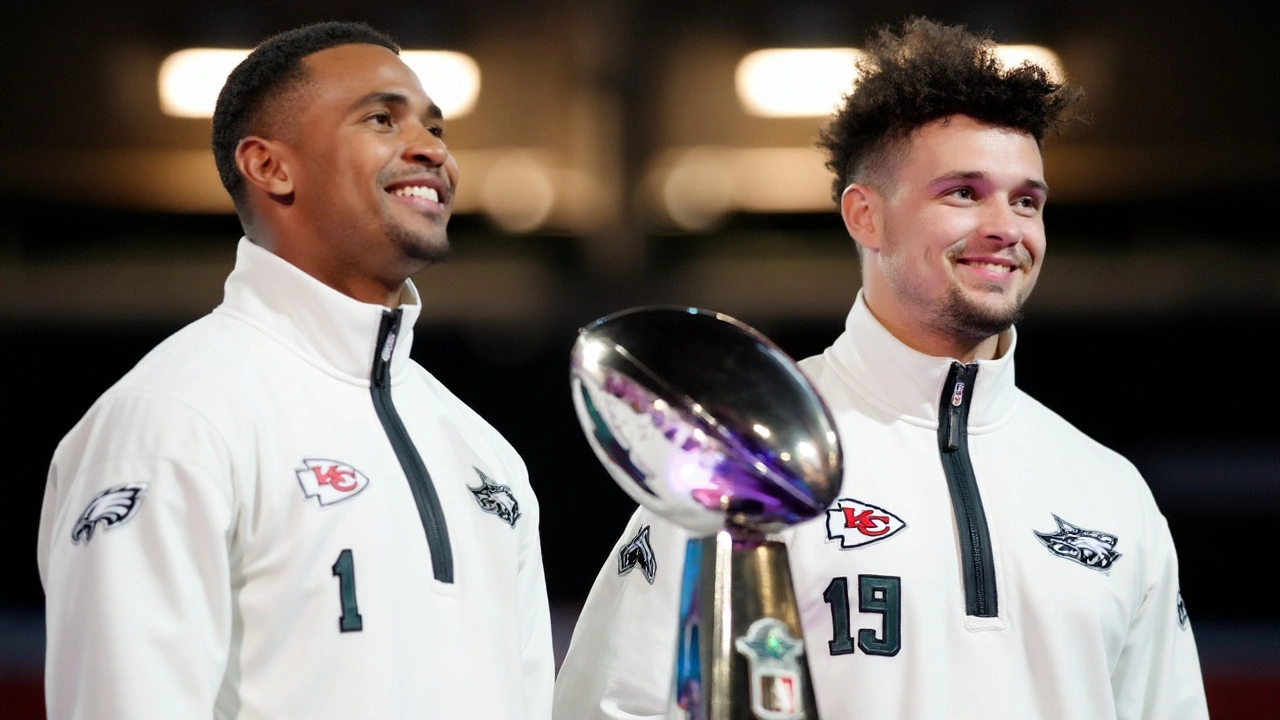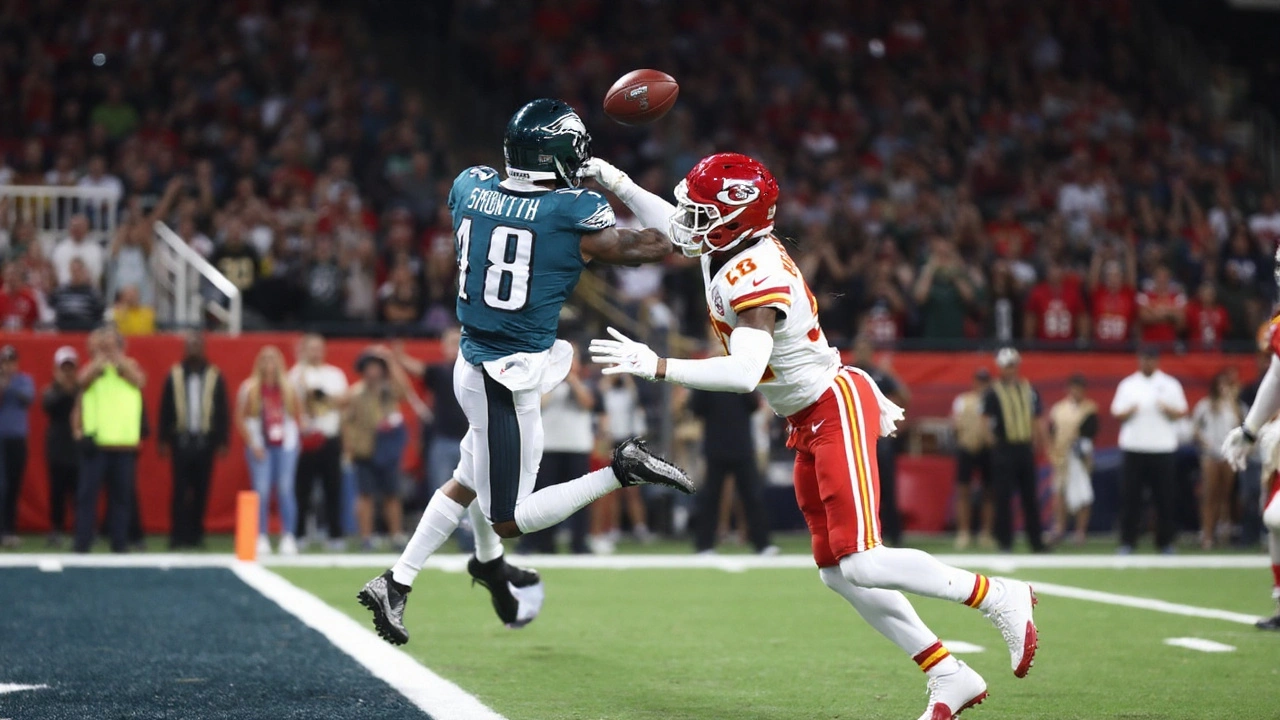
A heavyweight rematch settles on defense, field position, and nerve
Seventeen wins in their last 18 games. Seven straight overall. And now three in a row over Kansas City since that painful Super Bowl loss three seasons back. The defending champions went into Arrowhead on September 14, 2025, and left with a 20-17 win that felt like January football in mid-September—possession by possession, stop by stop, no frills, no panic.
Philadelphia jumped ahead early and never blinked. Jalen Hurts and Saquon Barkley each punched in rushing touchdowns, a reminder of how this offense punishes defenses that hesitate for even a beat on zone-read and QB-run looks. When the drive stalled shy of the red zone, Jake Elliott turned long distance into points—drilling field goals from 58 and 51 yards that shifted the math and the mood inside one of the loudest stadiums in the league.
The scoreline tells the rhythm: the Eagles stacked seven in the first quarter, then three in the second, three in the third, and seven in the fourth. Kansas City’s 10-point burst before halftime kept the place buzzing, but Philadelphia kept the lid on explosive plays and tightened in the key moments. In the fourth quarter, safety Andrew Mukuba read Patrick Mahomes, jumped the throw, and snagged the interception that changed everything as the Chiefs threatened to tie or even take the lead.
That single play will replay in Philly all week, not just because it ended a drive but because of when it arrived—right when Arrowhead felt ready to flip the game. It was the kind of snap that tilts a season’s storylines. It also underlined how Philadelphia won: disguise, discipline, and finishing. The coverage rotated late, the rush kept lanes tight, and when Mahomes went to a window he usually owns, Mukuba stepped through it first.
Hurts wasn’t asked to play hero ball. He didn’t need to. The offense leaned into structure and leverage—designed quarterback keepers to widen the edges, Barkley working downhill to punish light boxes, and quick, safe throws that kept the chains honest. The ground game set the terms, even when the box score won’t shout it. In a place where communication gets scrambled and snap counts get jumpy, Philadelphia bought themselves calm with the run.
And then there was Elliott. A 58-yarder outdoors in Kansas City is not a routine attempt. Neither is 51 with the building surging. Those kicks reframed drives that could have died as empty possessions. They also nudged the Chiefs into a bind: press to catch up, or stick with the plan. Against this Eagles defense, pressing is risky.
Philadelphia’s front didn’t live in the backfield every down, but it didn’t need to. What mattered was containment. Keep Mahomes inside the pocket, make him throw from fixed points, and trust the back end to rally and tackle. The big plays that usually break Kansas City’s opponents never really arrived in bunches, and the red-zone moments that decide these games tilted green.
Afterward, head coach Nick Sirianni went straight to the ethos that carried them last winter. “Our job, especially early in the season, is find a way to win. Take pride in winning any way you possibly can. Work to get better throughout the week, and repeat,” he said. “I think when you come off a season like we came off last year the expectation is that you’re going to pick up where you left off. There are steps to this.” That’s not just coach-speak. It’s their identity—focus on the next series, not the last banner.
Context matters here. Philadelphia didn’t just beat Kansas City. They did it in Arrowhead. They did it with balance and patience—two long field goals, a steady run script, and a defense that trusted its rules. They did it with their new Super Bowl pedigree showing, resisting the urge to chase splashy plays and instead winning the middle of the game: field position, game management, and fourth-quarter poise.
For Kansas City, the loss raises familiar early-season questions. When the offense faced a defense that refused to bust coverages, the rhythm wasn’t there for long stretches. Drives needed perfect execution to last, and the small mistakes—late reads, contested throws, tackles that held to second-and-long instead of first-and-10—added up. The Chiefs still had shots, because they always do with Mahomes, but the Eagles didn’t grant the cheap yards that often precede the backbreaker.
There’s also the storyline within the storyline: since that Super Bowl in February three years ago, the Eagles have grown into the team that now wins this matchup with patience. The last time these teams saw each other on a stage like this, Kansas City’s late-game magic decided it. In this one, it was Philadelphia’s late-game composure.
The texture of the night says plenty. The Eagles used tempo sparingly, adjusted splits to help the run game, and leaned on their interior to control first contact. Hurts’ designed keepers forced the second level to widen, opening the creases Barkley needs to turn three yards into five. On money downs, the call sheet stayed practical. Nothing cute, nothing reckless, just enough to keep the Chiefs from keying on one answer.
Defensively, the plan survived the usual Mahomes counterpunches. Edge rushers didn’t sell out upfield and create escape alleys. The linebackers squeezed crossers, and the secondary finished tackles instead of watching five-yard gains turn into 20. When a coverage bust could have flipped momentum, they didn’t bust. When a sudden-change moment begged for panic, they didn’t panic. That’s how you hold this offense to 17 on their own field.
Philadelphia’s scoring pattern—7-3-3-7—says they were comfortable taking the game in pieces. Every three mattered. Elliott’s early bomb from 58 worked like a message: if you cede midfield, we can still score. His 51-yarder later doubled down. Those decisions from the sideline mattered too. Sirianni didn’t chase fourth-down glory spots that weren’t there; he trusted his kicker and his defense, and the math worked.
Kansas City’s 10-point second quarter will nag the Eagles’ staff during film, because the standard is high. But holding the Chiefs to seven points after halftime on that field is the kind of number that wins championships in January, never mind Week 2. The fourth quarter hinged on one takeaway and one four-minute mindset: protect the ball, force timeouts, and make Kansas City play the long game. They did, and the clock blinked to zeros with the crowd stuck waiting for a comeback that never came.
Mukuba’s interception deserves an extra beat. The play didn’t happen by accident. It looked like a late rotation, the kind that invites a throw at the seam or an in-breaker. Mahomes tried to fit it. Mukuba slid under it. The reaction on the Eagles sideline said it all—helmets flying up, coaches pointing to the box, players signaling “ball.” That’s a defense living in its rules and trusting the film work that set up that exact look.
On the other side, Barkley’s touchdown run captured why he fits this roster. Philadelphia doesn’t need him to carry the offense every week. They need him to cash in the hard yards, punish light boxes, and make safeties think twice about firing downhill. He did just that, and the pile moved with him. Hurts’ rushing score was all about leverage—pads low, push behind him, a surge that made a narrow crease look wide.
Philadelphia is now 2-0 and already back in stride. The Super Bowl run last winter wasn’t a fluke; this is a team with a clear formula: control the line, minimize giveaways, and let the defense force one big mistake. It’s not flashy, but it travels. And when you add a kicker with range like Elliott’s, close games tilt in your favor more often than not.
Kansas City will be fine if they clean up the little things and stop asking Mahomes to conjure margin out of thin air every drive. The defense didn’t fold; it just faced a patient offense and a kicker who stole points from distances most kickers don’t touch. The offense had chances late and met a secondary that closed the door. That’s the difference between 2-0 and 1-1 in a league with razor-thin gaps.
The wider history will latch on to the rivalry arc—these teams keep crossing paths in moments that feel bigger than a week in September. The latest chapter went to Philadelphia, and it looked like this: a controlled run game, two deep field goals, a fourth-quarter takeaway, and a coach comfortable living in the margins.
Next up for the Eagles is a Sunday date on September 21, a quick turn from an emotional win. The challenge after a game like this is mental. Keep the edge, keep the routine, and bank the tape corrections without letting the win become a distraction. Sirianni’s group has earned some trust there. They got the banner in February by living in the week. Nothing about this performance suggests they’re changing the formula now.
As for the rematch label, the badge fits. This wasn’t fireworks; it was craft. It was about stacking small wins until the game tips. A goal-line shove here, a 58-yard boot there, a disguised look at the right time. The big moments were earned by a hundred small decisions. That’s championship football in any month.
Arrowhead will remember the noise and the near-miss. Philadelphia will remember the points and the pick. On a night that felt like more than Week 2, the champs left with the only thing that matters in a building like that—another signature road win against a heavyweight they used to chase and now routinely beat in tight games. For a league that thrives on narratives, this one’s simple: the defense travels, the kicker’s clutch, and the run game closes.
- Final: Philadelphia 20, Kansas City 17
- Scoring by quarter (PHI): 7-3-3-7
- Scoring by quarter (KC): 0-10-0-7
- Jake Elliott: field goals from 58 and 51 yards
- Rushing TDs: Jalen Hurts, Saquon Barkley
- Defining play: Andrew Mukuba’s fourth-quarter interception of Patrick Mahomes
- Eagles streak: seven straight; 17-1 in last 18; three straight wins vs. Kansas City

The bigger picture: what this win says about both teams
The defending champs are showing the same traits that carried them through February: sturdy run game, situational efficiency, and a defense that finds takeaways in the fourth quarter. They didn’t need explosive plays to win at Arrowhead—they needed control. They got it, and when Kansas City challenged late, they had the answer waiting.
For the Chiefs, this is less a referendum than a reminder. Against top defenses, you can’t rely on freelancing to bail you out for four quarters. The small stuff—spacing, timing, finishing catches through contact, staying on schedule—has to hit. When it doesn’t, even Mahomes feels mortal. The calendar is on their side, and so is their track record. Clean the details, and the offense will look like itself again.
Some games become shorthand in a season. This one might end up as the clip coaches pull up in December to explain how to win a road fistfight: run the ball enough to set terms, hit the deep kicks when drives stall, keep Mahomes inside the pocket, and trust that one turnover will be there late. In a season full of fireworks, the Eagles vs Chiefs rematch went the other way: hard, smart, and tight. That’s the kind of win that ages well.
 Sports Analysis
Sports Analysis